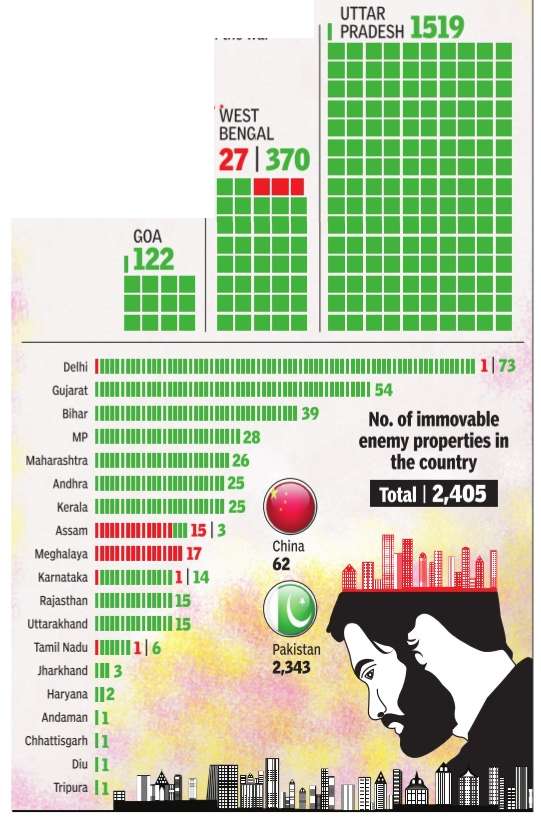Enemy Properties in India
This is a collection of articles archived for the excellence of their content. |
Contents |
The issue: a backgrounder
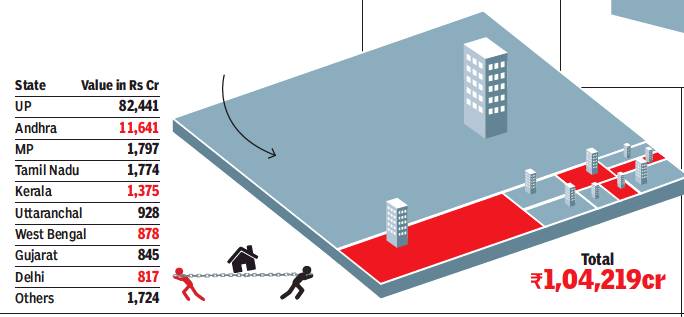
From: How some foreign nationals are set to lose 12,000 acres of land in India, April 2, 2018: The Times of India
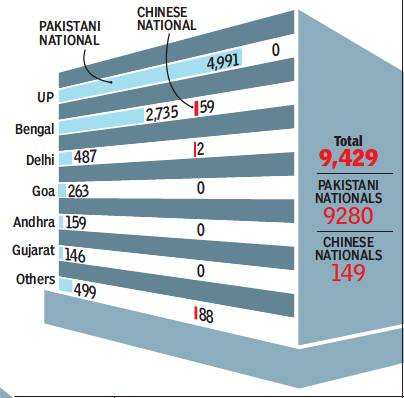
From: How some foreign nationals are set to lose 12,000 acres of land in India, April 2, 2018: The Times of India
A 49-year-old law was amended last week by Parliament to ensure successors of those who migrated to Pakistan and China during Partition have no claim over their properties and assets in India. Here’s what you need to know about ‘enemy property’
What is enemy property?
• After the 1962 conflict with China and the 1965 Indo-Pakistan war, the Indian government seized properties belonging to nationals of these countries. These properties, designated enemy property included land, buildings, firms, shares, bank balance, provident fund and so on. These properties are administrated by the Custodian of Enemy Property for India. The properties were seized in response to ‘enemy’ countries failing to compensate Indians whose property was seized or who fled these countries because of the war.
What is the valuation of these immovable properties?
• Responding to a question in Lok Sabha in 2017 the home ministry gave out details of 9,280 of these immovable properties that Pakistani nationals had to leave behind. Overall the property is spread across 12,000 acres of land and valued at over Rs 1 lakh crore
Was there an international agreement on these properties?
• In the 1966 Tashkent Declaration following the war between India and Pakistan, a clause was included that the two countries would discuss return of property and assets taken over by either side in connection to the conflict. The Pakistan government, however, sold all enemy property and assets owned by Indian citizens and companies in 1971 itself. In India, such properties continue to be under the control of the Custodian of Enemy Property.
Which state has the highest number of such properties?
• Together UP and West Bengal have over 80% of these immovable properties. Over 98% of it belongs to Pakistani nationals
Is it the first time such a rule is being enacted in India?
• No. After the beginning of the Second World War the British had enacted a Defence of India Act in 1939. Under this Act Germany, Italy and Japan were declared enemy countries and similar measures were adopted so their citizens should not be allowed to have any financial gain from India. After Independence, the Act was abrogated as the Indian government did not identify these countries as India’s enemy.
Enemy Properties
Uday Mahurkar , Spoils of war “India Today” 5/2/2018
See graphic
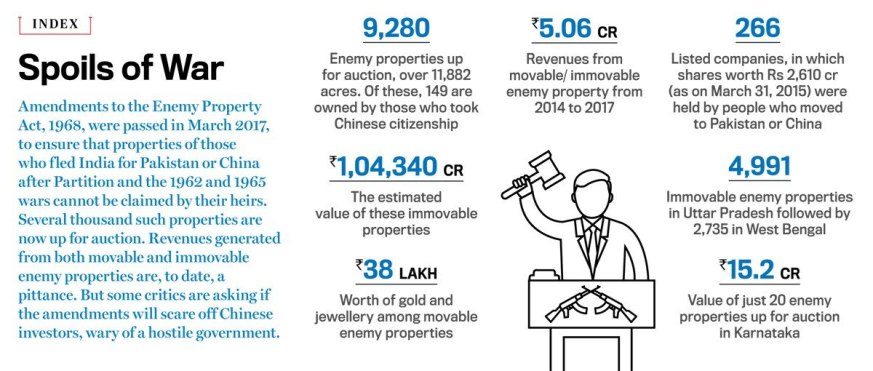
The magnitude of the problem
Number of immovable properties: 2014
Dec 31 2014
BEHIND ENEMY LINES?
After the 1962 conflict with China and the 1965 Indo-Pakistan war, the Indian government seized properties belonging to nationals of these countries. Designated as enemy property, these included land, buildings, firms, shares, bank balances, provident funds and so on. These properties are administrated by the Custodian of Enemy Property for India. The properties were seized so that the `enemy' country at that time should not get away from its responsibility of compensating Indians whose property was seized or who fled these countries because of the war
Enemy properties are worth Rs 1.04 lakh crore/ 2017
Enemy properties valued at Rs 1L cr, Mar 29, 2017: The Times of India
The government told the Lok Sabha on Tuesday that the gross total valuation of 9,280 `enemy properties' across the country stands at approximately Rs 1.04 lakh crore, with Uttar Pradesh accounting for the highest share with 4,991 properties valued at Rs 82,441crore.
The total area of the enemy properties in India is 11,773 acres, minister of state for home Hansraj Gangaram Ahir told the Lok Sabha in a written reply .
In terms of valuation of enemy properties, Andhra Pradesh follows UP as a distant second. It has 159 proper ties having a total gross valuation of Rs 11,641crore. Madhya Pradesh has 88 enemy properties worth Rs 1,796 crore, while Tamil Nadu has 34 properties with a total valuation of 1,773 crore. Kerala accounts for 60 enemy properties worth a total Rs 1,375 crore. Delhi has 487 enemy properties with a gross valuation of Rs 817 crore.
“Enemy property“ refers to any property belonging to, held or managed on behalf of an enemy , an enemy subject or an enemy firm.
The government has vested these properties in the Custodian of Enemy Property for India, an office instituted under the central government.
State-wise
Goa
The ministry of home affairs (MHA) has identified 263 enemy properties worth over 100 crore in the state that belong to Goans who have acquired Pakistani nationality . These properties assume significance as the Union government intends to take them over by passing a law in Parliament.
Enemy properties are those whose survey numbers are registered in the names of Goans who migrated to Pakistan decades ago. After these Goans accepted Pakistani citizenship and India declared Pakistan an enemy state around 1965, their properties were declared ene my properties. Most such properties are located in the talukas of Bardez and Salcete, while a few lie in Tiswadi, Bicholim and other parts of the state.
The MHA has forwarded a list of enemy properties to both district collectors and has directed them to collect the lease rent from their occupants. Sources said several people have already approached courts, staking claim to these properties.
On September 11, 1965, a central government notification stated that all immoveable properties in India belonging to, or held, or managed on behalf of Pakistani nationals were to be treated as enemy properties, and that control over them was to be vested in the custodian of enemy property .
Matters relating to enemy property are dealt with under Enemy Property Act, 1968 and Enemy Property Rules, 2015.
Presently, all cases involving enemy properties are being dealt under the Enemy Property (amendment and validation) Ordinance promulgated by the President of India on January 7, 2016.
The Centre sold over Rs 1,100 crore worth of Wipro shares. The shares were lying with the Union home ministry’s Custodian of Enemy Property of India.
The sale appears to be the first such by the government. The shares, belonging to Pakistani nationals, were seized by India under the Enemy Property Act passed in 1968, following the conflicts with Pakistan and China in the 1960s.
CEPI sold 4.3 crore shares in the Azim Premji-owned company for Rs 258 apiece. Most of it, 3.9 crore, was bought by the Life Insurance Corporation of India (LIC).
An estimated Rs 3,000 crore in shares and over Rs 1 lakh crore in immovable property (mostly land) are said to be with CEPI.
The sale of Wipro shares became possible following an amendment to the Enemy Property Act in 2017 to ensure that successors of those who migrated to Pakistan and China during Partition would have no claim over the properties left behind.
The amendment was done to overcome a Supreme Court clarification of 2005 that said the Custodian was merely an administrator and the ownership of the assets rested with the owner. The court said that on the death of the enemy owner (the person who moved to Pakistan or China), the property should be inherited by his or her legal heirs (who may be Indians). This had prompted some of the heirs in India to lay claim to the assets.
Last November, the Cabinet approved the mechanism and procedure to sell enemy shares. It also said the sale proceeds would be deposited as disinvestment proceeds with the finance ministry.
In February, a high-level panel was set up to recommend the quantum and price for the sale of shares. The Wipro sale appears to be the first sale under this process. The shares are said to have belonged to two Pakistani nationals.
Pakistan too had similarly acquired properties of those who had moved to India. It is said to have liquidated these assets.
4.3cr shares in the Azim Premji-owned co were sold for ₹258 apiece. Most of it — 3.9cr — was bought by LIC. The shares are said to have belonged to two Pakistanis
Utilisation of enemy properties’
2020: Uttarakhand
Prashant Jha, October 11, 2020: The Times of India
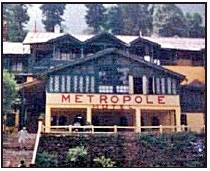
From: Prashant Jha, October 11, 2020: The Times of India
Almost a century after Muhammad Ali Jinnah, the founding father of Pakistan, spent his honeymoon at Nainital’s Metropole Hotel, a part of the hotel — which was designated as ‘enemy property’ in the 1960s — is being developed as a parking spot for tourists visiting the town. This would be one of the first instances of an ‘enemy property’ being put to public use anywhere in India.
In March last year, the Centre had allowed state governments to put to public use some enemy properties that were left behind by people who migrated to Pakistan since the Partition and to China after the 1962 India-China war. In Uttarakhand, the state government has directed the DMs in all 13 districts to evaluate their value. Nainital DM Savin Bansal told TOI, “We have disbursed an amount of Rs 42 lakh to develop infrastructure at the site. The plan is to develop a hightech parking spot there”.
Metropole Hotel was regarded as one of the finest hotels in Nainital at the turn of the century. “Jinnah came to Nainital with his wife Rattanbai and spent a week at the hotel in April 1919. The hotel was owned by the Raja of Mahmudabad, Mohammad Amir Ahmed Khan and had over 75 rooms,” said historian Ajay Singh Rawat.
According to the information submitted by the home ministry in Lok Sabha in March, India has 12,426 enemy properties.
YEAR-WISE DEVELOPMENTS
2016: Amendment and Validation Ordinance
The Times of India Jan 10 2016
Yusra Husain
Lucknow
Ordinance Gives The Custodians Full Rights
If those who left India for Pakistan after 1947 and during the Indo-Pak wars of 1965 and 1971 were dubbed “enemy subjects“, an ordi nance signed by President Pranab Mukherjee last week now decrees that even their heirs cannot inherit proper ty they owned, even if they are Indian citizens.
The decision on heirs of enemy property comes close to half a century after the Enemy Property Act was first promulgated in 1968. Earlier, there was ambiguity around whether Indian citizens could “inherit“ property belonging to “enemy subjects“.
The ordinance, which amends the Enemy Property Act, 1968, retrospectively , says the heirs will not have any right on ancestral property that has been marked “enemy property“. And it has vested powers in the government custodian of all enemy property in India to sell the said properties off, without compensation.
The ordinance outlines that once an enemy property is taken up by the custodian, it will remain so even in case of death of the “enemy subject“ or “extinction of the enemy“.The ordinance will be tabled in Parliament in its next session.
The Modi government has repeatedly declared that it is averse to retrospective changes in laws. Interestingly, however, the ordinance does just that by saying that the various substitutions being made in clauses of the Enemy Property Act, 1968, “shall always be deemed to have been substituted“.
The Enemy Property (Amendment and Validation) Ordinance, 2016, comes at a time when Raja Mohammad Amir Mohammad Khan, known as Raja Mahmudabad, is fighting a legal battle in the Supreme Court to get back his property from the “custodian“, entitled to him by a previous Supreme Court order.
In October 2005, Khan had won a 40-year battle to free his inheritance from the infamous tag of “enemy property“.
Raja Mahmudabad's father had migrated to Pakistan in 1957, while his mother, Rani Kaniz Abid, and he chose not to migrate and remained Indian citizens at all times. In 1965, after hostilities between India and Pakistan broke out, the Enemy Property (Custody and Registration) Order, 1962, was issued.
Under this, all immovable properties in India belonging to Pakistani citizens were taken over by the custodian.This vesting of property continued till 1977. Reacting to the amendments that have been brought with the new ordinance, Raja Mahmudabad, whose assets are spread across Uttar Pradesh and Uttarakhand, said: “The matter is sub judice. But, as I understand, the Indian government is trying to take away rights of the Indian citizen. I am fighting that.“
It was in 1973, when his father died in London, that Raja Mahmudabad inherited properties under the Oudh Estate Act, 1869, and as a citizen of India himself, contested that he be handed over the properties.
He was given relief in 2005 by the Supreme Court that passed an order in his favour, and some of his properties in Lucknow and Nainital were re-vested to him only to be seized again by the custodian in keeping with an ordinance of the Act in 2010.
As per the Enemy Property Act, the custodian had temporary right over enemy property . Within this, the custodian was to manage, preserve and look after its administration on behalf of the “enemy subject“.
The income that was generated from these properties, if sold or rented out, was submitted to the account of the “enemy subject“. However, with the current ordinance, the custodian will have full rights over the properties concerned, as well as the rights to sell them off as soon as the central government provides a timeframe for it.
The income generated on it thus, will be deposited to the Consolidated Fund of India with details provided to the Centre.
2017
2017, SC: government gets enemy properties, descendants of erstwhile owners don’t
Enemy property must go to govt, says SC, Feb 7, 2017: The Times of India
`No Transfer To Erstwhile Owners' Descendants'
The Supreme Court said enemy property should not get transferred to the descendants of the erstwhile owners and must go to the government.
“We are of the view that enemy property should not get transferred to the descendants of the erstwhile owners. It must go to the government. We are very clear about it,“ a bench of Chief Justice J S Khehar and Justice N V Ramana said.
The court refused to entertain Congress Rajya Sabha MP Husain Dalwai's writ petition challenging the validity of the Centre's decision to re-promulgate the enemy property ordinance for the fifth time, terming it a violation of a recent constitution bench decision.
“This is a very sensitive issue for the security of the nation. We have perused the constitution bench judgment.There cannot be a hard and fast rule. You are an MP . You get the debate started in Parliament. Everyone's right should be protected but you must also be sensitive towards national security ,“ the bench added.
Senior advocate Anand Grover continued to plead that re-promulgation of the enemy property ordinance was contrary to the law laid down by the SC but the bench was unmoved.
Finding it difficult to convince the bench, Grover withdrew the petition. The Enemy Property (Amendment and Validation) Ordinance, 2016 was promulgated by the President on January 7, 2016 to amend the Enemy Property Act, 1968 and the Public Premises (Eviction of Unauthorised Occupants) Act, 1971. A bill on the same lines was passed in Lok Sabha on March 9, 2016. The next day , it was laid before Rajya Sabha, which referred it to a select committee on March 15. A day later, Parliament was adjourned. The ordinance was repromulgated on April 2 last year. Parliament met again but no legislative action was taken. It was re-promulgated for the third time on May 31, 2016. The process continued and it was re-promulgated for the fifth time on December 22 last year and the government did not even care to specify what the grave urgency was for re-promulgating the ordinance.
The petitioner had cited the January 2 judgment in Krishna Kumar Singh case by a constitution bench of the SC, which ruled, “Re-promulgation of ordinances is constitutionally impermissible since it represents an effort to overreach the legislative body which is the primary source of law making authority in a parliamentary democracy .“
2017/ Enemy Property (Amendment and Validation) enacted
Enemy property bill passed, March 15, 2017: The Times of India
Rajnath: Law Doesn't Violate Human Rights
Lok Sabha passed the Enemy Property (Amendment and Validation) Bill, 2016, which denies inheritance rights to heirs of individuals who left the country for Pakistan and China, completing the process after Rajya Sabha gave its assent to the long pending legislation last week.
The amendment was necessitated by the claim made by the Raja of Mahmudabad of Uttar Pradesh on properties belonging to his father which were declared enemy property and seized by the government of India following partition.
Lok Sabha had to pass a fresh bill to approve the amendments introduced by the upper House on the recommendations of the select committee which considered the legislation. While RSP member N K Premachandran moved an amendment, it was turned down.
Home minister Rajnath Singh said the purpose of the bill was to clarify the rules that inheritance law would not apply to enemy pro perty , a question which first arose in 2010. The government had passed an ordinance to enforce the law.
Singh denied the contention of some MPs that the bill was against “natural justice“ and “human rights“, stating that Pakistan had seized the properties of Indian citizens and it was only natural that the property of those who migrated to Pakistan was not returned. Among those who spoke on the bill were Trinamool Congress MP Saugata Roy , Congress's Adhir Ranjan Choudhary , CPM's Mohd Salim and RJD's J P Yadav among others.
Home minister Singh sought to raise the temperature around the claim of Raja of Mahmudabad by citing from the evidence of Uttar Pradesh on “talukdari“ where the state had linked the royal family's fiefdom to its collaboration with the English in suppressing the 1857 revolt.
He said a system, “Sanad kabooliat“, was instituted where the individuals who had helped suppress the 1857 revolt were given properties on the condition that they would pledge support to the English. Singh said Raja of Mahmudabad's ancestors had secured “talukdari“ by signing the bond with the English, hence neither the father nor the son could get rights to the properties.
1,519 properties in UP alone affected
Yusra Husain, March 15, 2017: The Times of India
The enemy property bill, which was passed by the Lok Sabha, will affect 1,519 properties in UP. The Raja of Mahmudabad, who holds 936 properties across UP and Uttarakhand, will be the most affected. After the bill turns into an Act, the custodian appointed by the Central government will take control of all the properties identified as `enemy property', seizing the heir's right to ancestral property.
As many as 622 of the 1519 properties in UP are already vested with the `custodian' and 897 are in the process. Sources at the custodian said that while the bill would now be sent to the legislative wing for ordaining the procedure to be followed, the custodian can only act once it receives guidelines from its Mumbai-based headquarters.
Retrospective amendment to the Enemy Property (EP) Act of 1968 will cause maximum impact to Raja of Mahmudabad. Some of his properties were given back to him after an SC order in 2005, which followed a longdrawn legal battle, only to be re-vested in the govern ment custodian on promulgation of the EP Ordinance of 2010. As the Raja went against the same in the SC, his matter has since then been sub-judice. The Raja had also challenged the ordinance promulgated in January 2016 calling it “wholly arbitrary and violative“ of his fundamental rights under Articles 14 and 21 of the Indian constitution.
Reacting to the passage of the bill, he said: “The government was in a rush to get this bill passed, motivated primarily to appease a limited section of a community with specific Hindutva views that are not upheld by its majority. I have hope in judiciary now. This will affect thousands of unheard voices.“
Father of the present Raja Mahmudabad had migrated to Pakistan in 1957 while his mother Rani Kaniz Abid and he himself chose not to migrate and remained Indian citizens at all times. In 1965, after hostilities between India and Pakistan broke out, the Enemy Property (Custody and Registration) Order, 1962 was issued.
It was in 1973, when his father died in London, that Raja Mahmudabad inherited the properties under Oudh Estate Act, 1869 and as a citizen of India himself, contested to be handed over the properties.
2018
Centre begins process of selling enemy properties
March 27, 2018: The Times of India
The government has initiated the process of sale of more than 9,400 enemy properties by issuing guidelines and directing the office of the custodian to submit the list of all such movable and immovable assets within three months.
The sale of enemy properties is expected to fetch around Rs 1 lakh crore for the government exchequer.
Officials said that the ministry of home affairs has also constituted a valuation committee at the district level, headed by the district magistrate, and an inter-ministerial disposal committee, headed by an additional secretary, so that the process could be completed in a timebound manner.
The move comes after the amendment of the Enemy Property (Amendment and Validation) Act 2017 and the Enemy Property (Amendment) Rules, 2018, which ensured that the heirs of those who migrated to Pakistan and China during partition and afterwards will have no claim over the properties left behind in India.
Enemy properties were those left behind by the people who took citizenship of Pakistan and China. There are 9,280 properties left behind by Pakistani nationals and 126 properties which belonged to Chinese nationals, a ministry official said.
The government has vested these properties in the Custodian of Enemy Property for India, an office instituted under the Central government. The office of the custodian should submit a list of all enemy properties to the Central government, the MHA said.
“A list of all vested enemy properties (movable and immovable) shall be prepared by the custodian for its submission to the Central government within three months from the publication of this order,” it said.
For the purpose of valuation of the immovable enemy property, a valuation committee will be constituted at the district level with the district magistrate as the chairman besides two other official members.
The committee shall consider the circle rate of the area where the property is situated or a rate fixed by the district administration as a mode of valuation of the property along with other valuation modes.
The custodian will prepare and submit the statewise list of the enemy properties along with their valuation to the Central government within one month from the date of receipt of the valuation report from the valuation committee. Among the 9,280 properties left behind by Pakistani nationals, the highest 4,991properties are located in Uttar Pradesh followed by West Bengal which has 2,735 such estates. There are 487 such properties in Delhi. Among the 126 properties left behind by Chinese nationals, the highest 57 are located in Meghalaya followed by West Bengal with 29.
See also
Enemy Properties in India
